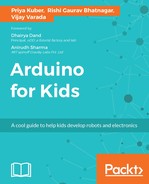Before we start, what is an IDE? IDE stands for Integrated Development Environment (it is nothing but a fancy name for software!). It contains a lot of useful tools we will use hereon for all our projects.
We write code in the IDE, and we call it a sketch. IDE converts the code we write to a language that our Arduino boards understand; this process is called compilation. Before doing that, it checks for any errors we might have made in the code.
IDE can only check for syntax errors not the logical errors. Syntax errors are the errors in the arrangement of words while we type that code. This arrangement should match the norms that are defined by the language. IDE is not going to let you proceed to upload the code until all the syntax errors are corrected by you. Most of the mistakes I have done have been in missing out on writing ; at the end of each line of code.
Other syntax errors include not declaring the variables properly, using variable names in the code without declaring them in advance, and so on.
Now let's get into more details about the IDE.
When you open the Arduino IDE, this is what the top section of the IDE will look like:

The red, yellow, and green buttons are to close, minimize, and maximize the IDE window respectively. I use a Mac, so the position of the buttons might change if you are using a Windows or Linux Machine.
The following section consists of a lot of very useful buttons:
|
Buttons |
Description |
|
|
This is the verify button. Its job is to check for any errors. |
|
|
Is the upload button. It compiles the code that we have written and uploads it to the configured board. We will learn in the following section that Arduino IDE lets us work with a variety of boards, both from Arduino (called Genuino outside USA) and anyone else who has built a board compatible with the Arduino. Isn't that phenomenal? |
|
|
Is the new button. It creates a new sketch for you whenever you want. |
|
|
Is the open button. It shows a menu of all the sketches in your sketchbook. Sketchbook, as you may have already guessed, is the place where all your sketches are saved. |
|
|
Is the save button. It saves your code. |
|
|
Is the Serial Monitor button. It opens the serial monitor. We will learn more about the Serial Monitor soon. |
You can find more tools within the five menus: File, Edit, Sketch, Tools, Help.
Here I would like you to experiment again. As part of building a process, we will learn how to use online resources to find solutions to problem we come across.
Note
Here is a link https://www.arduino.cc/en/Guide/Environment that explains, in detail, what each of the aforementioned tools do. Find out more about these tools and start writing down your learning in your notebook.
